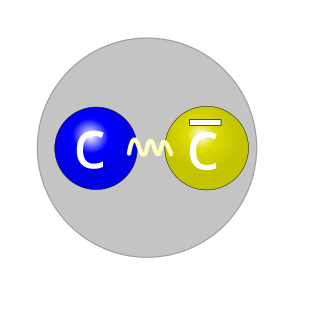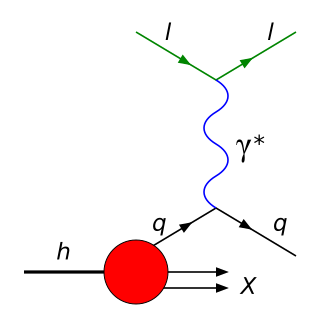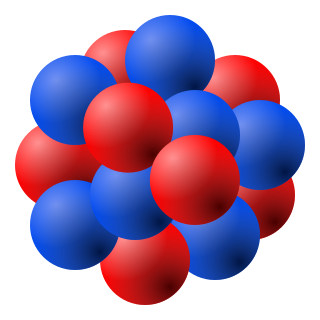Related Research Articles

In particle physics, a hadron is a composite subatomic particle made of two or more quarks held together by the strong interaction. They are analogous to molecules that are held together by the electric force. Most of the mass of ordinary matter comes from two hadrons: the proton and the neutron, while most of the mass of the protons and neutrons is in turn due to the binding energy of their constituent quarks, due to the strong force.

In physics, a subatomic particle is a particle smaller than an atom. According to the Standard Model of particle physics, a subatomic particle can be either a composite particle, which is composed of other particles, or an elementary particle, which is not composed of other particles. Particle physics and nuclear physics study these particles and how they interact. Most force carrying particles like photons or gluons are called bosons and, although they have discrete quanta of energy, do not have rest mass or discrete diameters and are unlike the former particles that have rest mass and cannot overlap or combine which are called fermions.

The
J/ψ
(J/psi) meson is a subatomic particle, a flavor-neutral meson consisting of a charm quark and a charm antiquark. Mesons formed by a bound state of a charm quark and a charm anti-quark are generally known as "charmonium" or psions. The
J/ψ
is the most common form of charmonium, due to its spin of 1 and its low rest mass. The
J/ψ
has a rest mass of 3.0969 GeV/c2, just above that of the
η
c, and a mean lifetime of 7.2×10−21 s. This lifetime was about a thousand times longer than expected.
A hypernucleus is similar to a conventional atomic nucleus, but contains at least one hyperon in addition to the normal protons and neutrons. Hyperons are a category of baryon particles that carry non-zero strangeness quantum number, which is conserved by the strong and electromagnetic interactions.

Exotic hadrons are subatomic particles composed of quarks and gluons, but which – unlike "well-known" hadrons such as protons, neutrons and mesons – consist of more than three valence quarks. By contrast, "ordinary" hadrons contain just two or three quarks. Hadrons with explicit valence gluon content would also be considered exotic. In theory, there is no limit on the number of quarks in a hadron, as long as the hadron's color charge is white, or color-neutral.

In particle physics, deep inelastic scattering is the name given to a process used to probe the insides of hadrons, using electrons, muons and neutrinos. It was first attempted in the 1960s and 1970s and provided the first convincing evidence of the reality of quarks, which up until that point had been considered by many to be a purely mathematical phenomenon. It is an extension of Rutherford scattering to much higher energies of the scattering particle and thus to much finer resolution of the components of the nuclei.

The Drell–Yan process occurs in high energy hadron–hadron scattering. It takes place when a quark of one hadron and an antiquark of another hadron annihilate, creating a virtual photon or Z boson which then decays into a pair of oppositely-charged leptons. Importantly, the energy of the colliding quark-antiquark pair can be almost entirely transformed into the mass of new particles. This process was first suggested by Sidney Drell and Tung-Mow Yan in 1970 to describe the production of lepton–antilepton pairs in high-energy hadron collisions. Experimentally, this process was first observed by J. H. Christenson et al. in proton–uranium collisions at the Alternating Gradient Synchrotron.

CDHS was a neutrino experiment at CERN taking data from 1976 until 1984. The experiment was officially referred to as WA1. CDHS was a collaboration of groups from CERN, Dortmund, Heidelberg, Saclay and later Warsaw. The collaboration was led by Jack Steinberger. The experiment was designed to study deep inelastic neutrino interactions in iron.

Main Injector Experiment for ν-A, or MINERνA, is a neutrino scattering experiment which uses the NuMI beamline at Fermilab. MINERνA seeks to measure low energy neutrino interactions both in support of neutrino oscillation experiments and also to study the strong dynamics of the nucleon and nucleus that affect these interactions.
Kurt Gottfried was an Austrian-born American physicist who was professor emeritus of physics at Cornell University. He was known for his work in the areas of quantum mechanics and particle physics and was also a co-founder with Henry Way Kendall of the Union of Concerned Scientists. He wrote extensively in the areas of physics and arms control.

Quark–gluon plasma is an interacting localized assembly of quarks and gluons at thermal and chemical (abundance) equilibrium. The word plasma signals that free color charges are allowed. In a 1987 summary, Léon van Hove pointed out the equivalence of the three terms: quark gluon plasma, quark matter and a new state of matter. Since the temperature is above the Hagedorn temperature—and thus above the scale of light u,d-quark mass—the pressure exhibits the relativistic Stefan-Boltzmann format governed by temperature to the fourth power and many practically massless quark and gluon constituents. It can be said that QGP emerges to be the new phase of strongly interacting matter which manifests its physical properties in terms of nearly free dynamics of practically massless gluons and quarks. Both quarks and gluons must be present in conditions near chemical (yield) equilibrium with their colour charge open for a new state of matter to be referred to as QGP.
The EMC effect is the surprising observation that the cross section for deep inelastic scattering from an atomic nucleus is different from that of the same number of free protons and neutrons. From this observation, it can be inferred that the quark momentum distributions in nucleons bound inside nuclei are different from those of free nucleons. This effect was first observed in 1983 at CERN by the European Muon Collaboration, hence the name "EMC effect". It was unexpected, since the average binding energy of protons and neutrons inside nuclei is insignificant when compared to the energy transferred in deep inelastic scattering reactions that probe quark distributions. While over 1000 scientific papers have been written on the topic and numerous hypotheses have been proposed, no definitive explanation for the cause of the effect has been confirmed. Determining the origin of the EMC effect is one of the major unsolved problems in the field of nuclear physics.

Fermilab E-906/SeaQuest is a particle physics experiment which will use Drell–Yan process to measure the contributions of antiquarks to the structure of the proton or neutron and how this structure is modified when the proton or neutron is included within an atomic nucleus.

The nuclear drip line is the boundary beyond which atomic nuclei are unbound with respect to the emission of a proton or neutron.
The rms charge radius is a measure of the size of an atomic nucleus, particularly the proton distribution. The proton radius is about one femtometre = 10−15 metre. It can be measured by the scattering of electrons by the nucleus. Relative changes in the mean squared nuclear charge distribution can be precisely measured with atomic spectroscopy.
The polarized targets are used as fixed targets in scattering experiments. In high energy physics they are used to study the nucleon spin structure of simple nucleons like protons, neutrons or deuterons. In deep inelastic scattering the hadron structure is probed with electrons, muons or neutrinos. Using a polarized high energy muon beam, for example, on a fixed target with polarized nucleons it is possible to probe the spin dependent part of the structure functions.
The proton spin crisis is a theoretical crisis precipitated by a 1987 experiment by the European Muon Collaboration (EMC), which tried to determine the distribution of spin within the proton.
The nucleon magnetic moments are the intrinsic magnetic dipole moments of the proton and neutron, symbols μp and μn. The nucleus of an atom comprises protons and neutrons, both nucleons that behave as small magnets. Their magnetic strengths are measured by their magnetic moments. The nucleons interact with normal matter through either the nuclear force or their magnetic moments, with the charged proton also interacting by the Coulomb force.

The shape of the atomic nucleus been depicted as a compact bundle of the two types of nucleons that look like little balls stuck together, protons (red) and neutrons (blue). This depiction of the atomic nucleus approximates the empirical evidence for the size and shape of nucleons and nuclei as outlined in the article below, beginning with the discovery of the quadrapole moment in 1935 and its role in shape. Factors affecting nuclear shape include the prolate spheroid shape of the nucleon, the distance between nucleons, and the radial charge density distribution. The unusual cosmic abundance of alpha nuclides has inspired geometric arrangements of alpha particles as a solution to nuclear shapes, although the atomic nucleus generally assumes a prolate spheroid shape. Nuclides can also be discus-shaped, triaxial or pear-shaped.
References
- 1 2 3 4 "Joel M. Moss, Biography". American Institute of Physics (AIP).
- ↑ "Joel Marshall Moss". Physics Tree.
- ↑ "Abstract # 5673". Nuclear Science Abstracts, Volume 25, Number 3, Abstracts 4008-8192. United States Atomic Energy Commission, Division of Technical Information. February 15, 1971. p. 546.
- ↑ Youngblood, D. H.; Bacher, A. D.; Brown, D. R.; Bronson, J. D.; Moss, J. M.; Rozsa, C. M. (1977). "Particle decay from the giant resonance region of 40Ca". Physical Review C. 15 (1): 246–259. Bibcode:1977PhRvC..15..246Y. doi:10.1103/PhysRevC.15.246. hdl: 1969.1/126734 .
- 1 2 3 4 5 "1998 Tom W. Bonner Prize in Nuclear Physics Recipient, Joel M. Moss". American Physical Society.
- ↑ Enge, Harald A. (1958). "Combined Magnetic Spectrograph and Spectrometer". Review of Scientific Instruments. 29 (10): 885–888. Bibcode:1958RScI...29..885E. doi:10.1063/1.1716028.
- ↑ Moss, J.M.; Brown, D.R.; Cornelius, W.D. (1976). "Proton polarimetry using an Enge split-pole spectrograph". Nuclear Instruments and Methods. 135 (1): 139–143. Bibcode:1976NucIM.135..139M. doi:10.1016/0029-554X(76)90837-5.
- ↑ information from American Men and Women of Science, Thomson Gale 2004
- ↑ McGaughey, P. L.; Moss, J. M.; Peng, J. C. (December 1999). "High-Energy Hadron-Induced Dilepton Production from Nucleons and Nuclei". Annual Review of Nuclear and Particle Science. 49: 217–253. arXiv: hep-ph/9905409 . Bibcode:1999ARNPS..49..217M. doi:10.1146/annurev.nucl.49.1.217. S2CID 16426595.
- ↑ Vasiliev, M. A.; et al. (1999). "Parton Energy Loss Limits and Shadowing in Drell-Yan Dimuon Production". Physical Review Letters. 83 (12): 2304–2307. arXiv: hep-ex/9906010 . Bibcode:1999PhRvL..83.2304V. doi:10.1103/PhysRevLett.83.2304. S2CID 119409844.
- ↑ preprints of the E772 collaboration at LANL
- ↑ Hawker, E. A.; et al. (1998). "Measurement of the Light Antiquark Flavor Asymmetry in the Nucleon Sea". Physical Review Letters. 80 (17): 3715–3718. arXiv: hep-ex/9803011 . Bibcode:1998PhRvL..80.3715H. doi:10.1103/PhysRevLett.80.3715. S2CID 54921026. (over 600 citations)
- ↑ Alde, D. M.; Baer, H. W.; Carey, T. A.; Garvey, G. T.; Klein, A.; Lee, C.; Leitch, M. J.; Lillberg, J. W.; McGaughey, P. L.; Mishra, C. S.; Moss, J. M.; Peng, J. C.; Brown, C. N.; Cooper, W. E.; Hsiung, Y. B.; Adams, M. R.; Guo, R.; Kaplan, D. M.; McCarthy, R. L.; Danner, G.; Wang, M. J.; Barlett, M. L.; Hoffmann, G. W. (1990). "Nuclear dependence of dimuon production at 800 GeV". Physical Review Letters. 64 (21): 2479–2482. Bibcode:1990PhRvL..64.2479A. doi:10.1103/PhysRevLett.64.2479. PMID 10041723. (over 550 citations)
- ↑ Brooks, M. L.; Moss, J. M. (1997). "Heavy-Flavor Production via Single Muon Detection in the PHENIX Detector at √s= 200 GeV" (PDF). PHENIX Technical Note 361.
- ↑ Akikawa, H.; et al. (2003). "PHENIX Muon Arms". Nuclear Instruments and Methods in Physics Research Section A: Accelerators, Spectrometers, Detectors and Associated Equipment. 499 (2–3): 537–548. Bibcode:2003NIMPA.499..537A. doi:10.1016/S0168-9002(02)01955-1.
- ↑ "APS Fellow Archive". American Physical Society. (search on year=1983 and institution=Los Alamos National Laboratory)